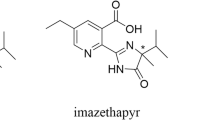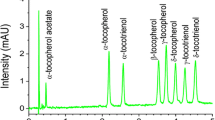Abstract
A novel, sensitive, and efficient enantioselective method for the determination of triadimefon and its metabolite triadimenol in edible vegetable oil, was developed by gel permeation chromatography and ultraperformance convergence chromatography/tandem triple quadrupole mass spectrometry. After the vegetable oil samples were prepared using gel permeation chromatography, the eluent was collected, evaporated, and dried with nitrogen gas. The residue was redissolved by adding methanol up to a final volume of 1 mL. The analytes of six enantiomers were analyzed on Chiralpak IA-3 column (150 × 4.6 mm) using compressed liquid CO2-mixed 14 % co-solvents, comprising methanol/acetonitrile/isopropanol = 20/20/60 (v/v/v) in the mobile phase at 30 °C, and the total separation time was less than 4 min at a flow rate of 2 mL/min. Quantification was achieved using matrix-matched standard calibration curves. The overall mean recoveries for six enantiomers from vegetable oil were 90.1–97.3 %, with relative standard deviations of 0.8–5.4 % intra-day and 2.3–5.0 % inter-day at 0.5, 5, and 50 μg/kg levels. The limits of quantification were 0.5 μg/kg for all enantiomers based on five replicate extractions at the lowest fortified level in vegetable oil. Moreover, the absolute configuration of six enantiomers had been determined based on comparisons of the vibrational circular dichroism experimental spectra with the theoretical curve obtained by density functional theory calculations. Application of the proposed method to the 40 authentic vegetable oil samples from local markets suggests its potential use in enantioselective determination of triadimefon and triadimenol enantiomers.

Chemical structures and UPC2-MS/MS separation chromatograms of triadimefon and triadimenol





Similar content being viewed by others
Abbreviations
- AC:
-
Absolute configuration
- CSP:
-
Chiral stationary phase
- DFT:
-
Density functional theory
- GPC:
-
Gel permeation chromatography
- MRL:
-
Maximum residue limit
- RSD:
-
Relative standard deviation
- SFC:
-
Supercritical fluid chromatography
- SSE:
-
Slope matrix-matched calibration/slope standard calibration in solvent
- VCD:
-
Vibrational circular dichroism
References
Gunstone FD (2011). Production and trade of vegetable oils. Vegetable oils in food technology pp. 1–24
Barrek S, Paisse O, Grenier-Loustalot MF (2003) Determination of residual pesticides in olive oil by GC-MS and HPLC-MS after extraction by size-exclusion chromatography. Anal Bioanal Chem 376:355–359
Menegola E, Broccia ML, Di Renzo F, Prati M, Giavini E (2000) In vitro teratogenic potential of two antifungal triazoles: triadimefon and triadimenol. In Vitro Cell Dev Biol Anim 36:88–95
U.S. Environmental Protection Agency (U.S. EPA) (2006) Reregistration eligibility decision for triadimefon and tolerence reassessment for triadimenol, EPA 738-R-06-003, U.S. Environmental Protection Agency, Washington, DC
Walker QD, Lewis MH, Crofton KM, Mailman RB (1990) Triadimefon, a triazole fungicide, induces stereotyped behavior and alters monoamine metabolism in rats. Toxicol Appl Pharmacol 102:474–485
Liang HW, Li L, Qiu J, Li W, Yang SM, Zhou ZQ, Qiu LH (2013) Stereoselective transformation of triadimefon to metabolite triadimenol in wheat and soil under field conditions. J Hazard Mater 260(1):929–936
Crowell SR, Henderson WM, Kenneke JF, Fisher JW (2011) Development and application of a physiologically based pharmacokinetic model for triadimefon and its metabolite triadimenol in rats and humans. Toxicol Lett 205:154–162
Garrison AW, Avants JK, Jones WJ (2011) Microbial transformation of triadimefon to triadimenol in soils: selective production rates of triadimenol stereoisomers affect exposure and risk. Environ Sci Technol 45:2186–2193
Kenneke JF, Ekman DR, Mazur CS, Konwick BJ, Fisk AT, Avants JK, Garrison AW (2010) Integration of metabolomics and in vitro metabolism assays for investigating the stereoselective transformation of triadimefon in rainbow trout. Chirality 22:183–192
Li ZY, Zhang YC, Li QL, Wang WX, Li JY (2011) Enantioselective degradation, abiotic racemization, and chiral transformation of triadimefon in soils. Environ Sci Technol 45:2797–2803
Dong FS, Liu XG, Zheng YQ, Cao Q, Li CJ (2010) Stereoselective degradation of fungicide triadimenol in cucumber plants. Chirality 22:292–298
Konwick BJ, Garrison AW, Avants JK, Fisk AT (2006) Bioaccumulation and biotransformation of chiral triazole fungicides in rainbow trout (Oncorhynchus mykiss). Aquat Toxicol 80:372–381
Deas AHB, Carter GA, Clark T, Clifford DR, James CS (1986) The enantiomeric composition of triadimenol produced during metabolism of triadimefon by fungi. III. Relationship with sensitivity to triadimefon. Pestic Biochem Physiol 26:10–21
Liu WP, Gan JY, Daniel S, William AJ (2005) Enantioselectivity in environmental safety of current chiral insecticides. Proc Natl Acad Sci U S A 102:701–706
Liu WP, Ye J, Jin M (2009) Enantioselective phytoeffects of chiral pesticides. J Agric Food Chem 57:2087–2095
Tonon MA, Jabor VA, Bonato PS (2013) Enantioselective analysis of zopiclone in rat brain by liquid chromatography tandem mass spectrometry. Anal Bioanal Chem 405:267–273
Kurihara N, Miyamoto J, Paulson GD, Zeeh B, Skidmore MW, Hollingworth RM, Kuiper HA (1997) Chirality in synthetic agrochemicals: bioactivity and safety consideration. Pure Appl Chem 69(6):1335–1348
Gilbert-López B, García-Reyes JF, Fernández-Alba AR, Molina-Díaz A (2010) Evaluation of two sample treatment methodologies for large-scale pesticide residue analysis in olive oil by fast liquid chromatography-electrospray mass spectrometry. J Chromatogr A 1217(24):3736–3747
García-Reyes JF, Ferrer C, Gómez-Ramos MJ, Molina-Díaz A, Fernández-Alba AR (2007) Determination of pesticide residues in olive oil and olives. Trac-Trend Anal Chem 26(3):239–251
Wu YS, Lee HK, Li SFY (2000) Simultaneous chiral separation of triadimenfon and triadimenol by sulfated β-cyclodextrin-mediated capillary electrophoresis. Electrophoresis 21:1611–1619
Wang P, Jiang SR, Liu DH (2005) Direct enantiomeric resolutions of chiral triazole pesticides by high-performance liquid chromatography. J Biochem Biophys Methods 62:219–230
Zhou Y, Li L, Lin KD, Zhu XP, Liu WP (2009) Enantiomer separation of triazole fungicides by high-performance liquid chromatography. Chirality 21:421–427
Luo M, Liu DH, Zhou ZQ, Wang P (2013) A new chiral residue analysis method for triazole fungicides in water using dispersive liquid-liquid microextraction (DLLME). Chirality 25:567–574
del Nozal MJ, Toribio L, Bernal JL, Castano N (2003) Separation of triadimefon and triadimenol enantiomers and diastereoisomers by supercritical fluid chromatography. J Chromatogr A 986:135–141
Toribio L, del Nozal MJ, Bernal JL, Jimenez JJ, Alonso C (2004) Chiral separation of some triazole pesticides by supercriticalfluid chromatography. J Chromatogr A 1046:249–253
Liang HW, Qiu J, Li L, Li W, Zhou ZQ, Liu FM, Qiu LH (2012) Stereoselective separation and determination of triadimefon and triadimenol in wheat, straw, and soil by liquid chromatography-tandem mass spectrometry. J Sep Sci 35:166–173
Wang YH, Yu DY, Xu P, Guo BY, Zhang YF, Li JH, Wang HL (2014) Stereoselective metabolism, distribution, and bioaccumulation brof triadimefon and triadimenol in lizards. Ecotoxicol Environ Saf 107:276–283
Li YB, Dong FS, Liu XG, Xu J, Han YT, Zheng YQ (2014) Chiral fungicide triadimefon and triadimenol: stereoselective transformation in greenhouse crops and soil, and toxicity to Daphnia magna. J Hazard Mater 265:115–123
Qian MR, Zhang H, Wu LQ, Jin N, Wang JM, Jiang KZ (2015) Simultaneous determination of zearalenone and its derivatives in edible vegetable oil by gel permeation chromatography and gas chromatography–triple quadrupole mass spectrometry. Food Chem 166:23–28
Sun HW, Yang YL, Li H, Zhang JX, Sun N (2012) Development of multiresidue analysis for twenty phthalate esters in edible vegetable oils by microwaveassisted extraction-gel permeation chromatography-solid phase extraction-gas chromatography-tandem mass spectrometry. J Agric Food Chem 60:5532–5539
Zhou Q, Gao B, Zhang X, Xu Y, Shi H, Yu LL (2014) Chemical profiling of triacylglycerols and diacylglycerols in cow milk fat by ultra-performance convergence chromatography combined with a quadrupole time-of-flight massspectrometry. Food Chem 143:199–204
Ramakrishna NVS, Vishwottam KN, Puran S, Manoj S, Santosh M, Koteshwara M (2004) Sensitive and rapid liquid chromatographic/electrospray ionization tandem mass spectrometric method for the quantification of lacidipine in human plasma. J Mass Spectrom 39(7):824–832
Baranda AB, Mueller CA, Alonso RM, Jimenez RM, Weinmann W (2005) Quantitative determination of the calcium channel antagonists amlodipine, lercanidipine, nitrendipine, felodipine, and lacidipine in human plasma using liquid chromatography-tandem mass spectrometry. Ther Drug Monit 27(1):44–52
Tang J, Zhu RH, Zhao RK, Cheng G, Peng WX (2008) Ultra-performance liquid chromatography–tandem mass spectrometry for the determination of lacidipine in human plasma and its application in a pharmacokinetic study. J Pharm Biomed Anal 47:923–928
Sun MY, Sun J, He SF, Wang YJ, Sun YH, Liu XH, He ZG (2012) Considerations in the development of an in vitro dissolution condition for lacidipine tablets: in vivo pharmacokinetic evaluation. Drug Dev Ind Pharm 38(9):1099–1106
Chen ZL, Dong FS, Xu J, Liu XG, Cheng YQ, Liu N, Tao Y, Pan XL, Zheng YQ (2014) Stereoselective separation and pharmacokinetic dissipation of the chiral neonicotinoid sulfoxaflor in soil by ultraperformance convergence chromatography/tandem mass spectrometry. Anal Bioanal Chem 406:6677–6690
European Commission DG-SANCO. Method validation and quality control procedures for pesticide residues analysis in food and feed 2012. No. SANCO/12495/2011
Sardella R, Ianni F, Lisanti A, Marinozzi M, Scorzoni S, Natalini B (2014) The effect of mobile phase composition in the enantioseparation of pharmaceutically relevant compounds with polysaccharide-based stationary phases. Biomed Chromatogr 28(1):159–167
West C, Bouet A, Routier S, Lesellier E (2012) Effects of mobile phase composition and temperature on the supercritical fluid chromatography enantioseparation of chiral fluoro-oxoindole-type compounds with chlorinated polysaccharide stationary phases. J Chromatogr A 1269:325–335
Bicker W, Lammerhofer M, Lindner W (2005) Determination of chlorpyrifos metabolites in human urine by reversed-phase/weak anion exchange liquid chromatography-electrospray ionisation-tandem mass spectrometry. J Chromatogr B 822:160–169
Gosetti F, Mazzucco E, Zampieri D, Gennaro MC (2010) Signal suppression/enhancement in high-performance liquid chromatography tandem mass spectrometry. J Chromatogr A 1217(25):3929–3937
Acknowledgments
This work was financially supported by the National Natural Science Foundation of China (no. 21207118), the Project of Science and Technology Plan of Zhejiang Province, China (no. 2014C37103), and the Natural Science Foundation of Zhejiang Province, China (no. Y15B070017).
Conflict of interest
The authors declare that they have no competing interests.
Author information
Authors and Affiliations
Corresponding author
Electronic supplementary material
Below is the link to the electronic supplementary material.
ESM 1
(PDF 3742 kb)
Rights and permissions
About this article
Cite this article
Yao, Z., Li, X., Miao, Y. et al. Simultaneous enantioselective determination of triadimefon and its metabolite triadimenol in edible vegetable oil by gel permeation chromatography and ultraperformance convergence chromatography/tandem mass spectrometry. Anal Bioanal Chem 407, 8849–8859 (2015). https://doi.org/10.1007/s00216-015-9046-y
Received:
Revised:
Accepted:
Published:
Issue Date:
DOI: https://doi.org/10.1007/s00216-015-9046-y




